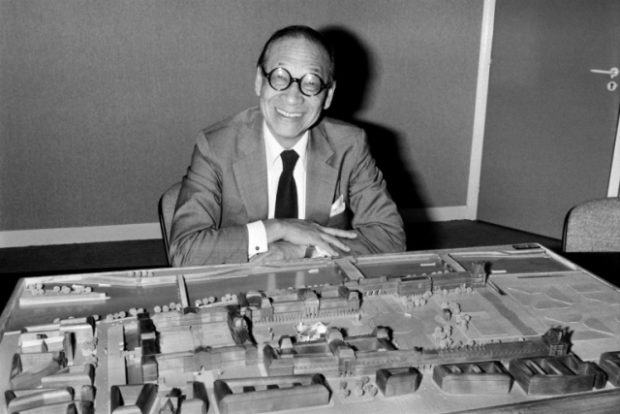I.M. Pei, a pillar of modern architecture, dies at 102

Architect I.M. Pei poses with the architectural model of the Louvre Pyramid in Paris in 1985. Image: POOL/Pascal George via AFP
I.M. Pei, the preeminent US architect who forged a distinct brand of modern building design with his sharp lines and stark structures, has died in New York, his sons’ architecture firm said Thursday. He was 102 years old.
The Chinese-born Pei was the mastermind behind the bold Louvre pyramid in Paris, the landmark 72-story Bank of China tower in Hong Kong and Athens’ Museum of Modern Art, works seen as embracing modernity tempered by a grounding in history.
Pei Partnership Architects confirmed Pei’s death to AFP. The New York Times, citing Pei’s son Li Chung, said the architect had died overnight Wednesday into Thursday.
In his adopted home country the United States, Pei became perhaps best known for his landmark East Building at Washington’s National Gallery of Art, deftly melding sharp modern angles with the monumental grandeur the US capital is known for.
“Contemporary architects tend to impose modernity on something. There is a certain concern for history but it is not very deep,” Pei told The New York Times in a 2008 interview. “I understand that times have changed, we have evolved. But I don’t want to forget the beginning.”
“A lasting architecture has to have roots.”
Born in China in 1917, banker’s son Ieoh Ming Pei came to the US at 17 to study architecture, receiving an undergraduate degree in the field from the Massachusetts Institute of Technology in 1940.
He then enrolled in Harvard University’s Graduate School of Design, where he received a master’s degree in architecture in 1946. He became a naturalized US citizen in 1954.
His revered projects include the Rock and Roll Hall of Fame and Museum in Cleveland, Ohio; the Miho Museum of Shigo, Japan; the Morton Meyerson Symphony Center in Dallas, Texas, and The John F. Kennedy Library in Boston, Massachusetts.
Despite being a confessed Islamic art novice, he was also commissioned to design the Museum of Islamic Art in Doha, Qatar, which opened in 2008 to great fanfare.
Architectural ‘poetry’
Pei dedicated energetic efforts through the years to supporting the arts and education, serving on visiting committees at the Metropolitan Museum of Art in New York, Harvard and MIT as well as a range of US government panels including the National Council on the Humanities and National Council on the Arts.
He dedicated the $100,000 prize money he was awarded as laureate of the Pritzker Architecture Prize to setting up a scholarship fund for Chinese students to study the craft in the United States, on the condition they return home to design and build.
In 1975, Pei was elected to the American Academy and Institute of Arts and Letters. Three years later he became Chancellor of the Academy, the first architect to hold the position.
He was also one of 12 naturalized US citizens then-president Ronald Reagan awarded the Medal of Liberty in 1986.
In 1988, then-French president Francois Mitterrand inducted Pei as a Chevalier in the Legion d’Honneur, later raising him to the rank of Officier when Phase II of the glass-and-stainless steel Grand Louvre pyramid was completed in 1993.
US president George Bush awarded Pei the Medal of Freedom that same year, when he was also elected an Honorary Academician of the Royal Academy of Arts in London.
In addition to his museum oeuvre and contributions to the government and commercial landscape, Pei also worked on moderate and low-income housing.
“His concern has always been the surroundings in which his buildings rise,” wrote the Pritzker jury that bestowed to him in 1983 architecture’s most prestigious prize.
“His versatility and skill in the use of materials approach the level of poetry,” the committee wrote. “His tact and patience have enabled him to draw together peoples of disparate interests and disciplines to create a harmonious environment.” CC
RELATED STORIES:
Pritzker Prize, Irish-born architect Kevin Roche dies